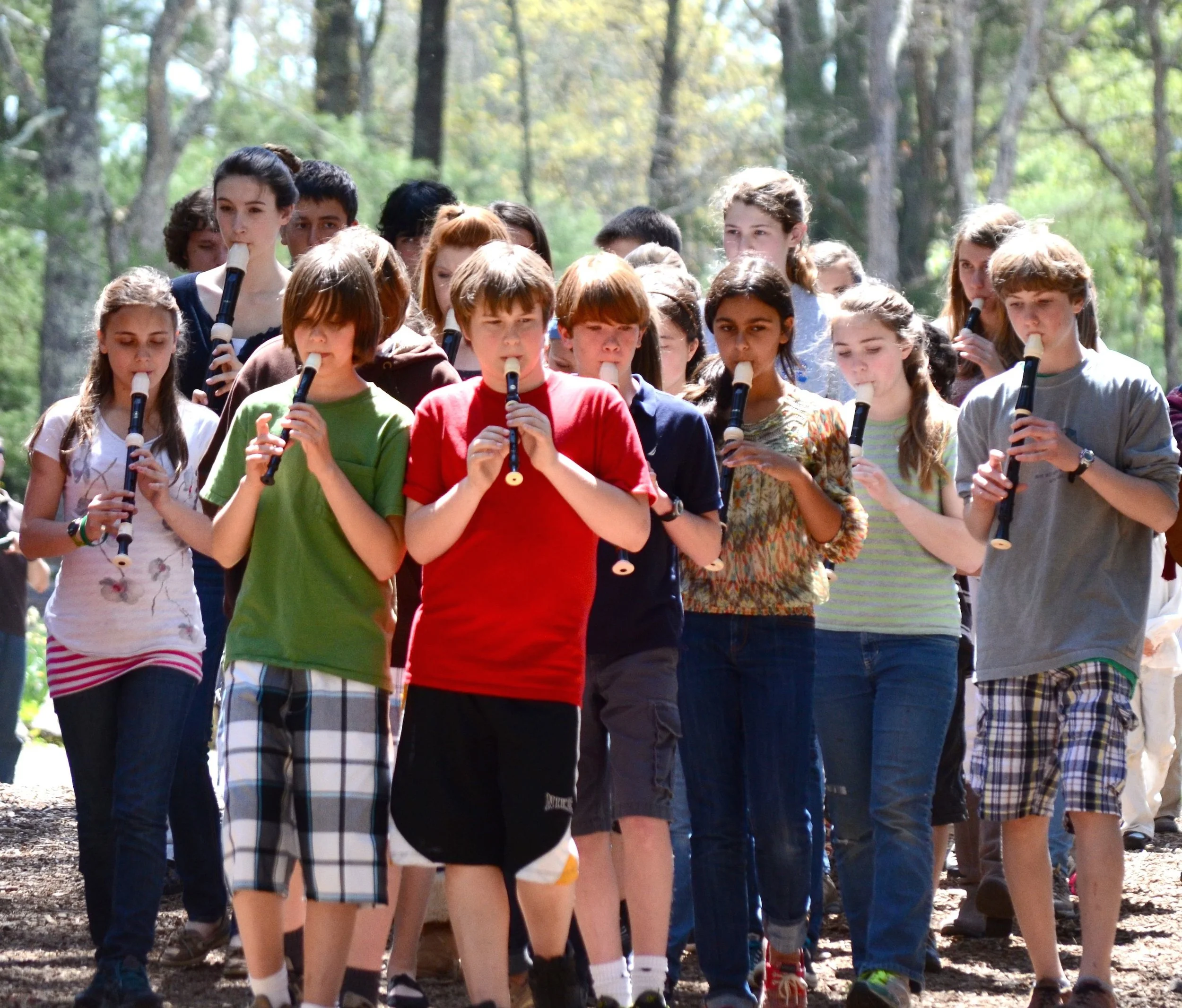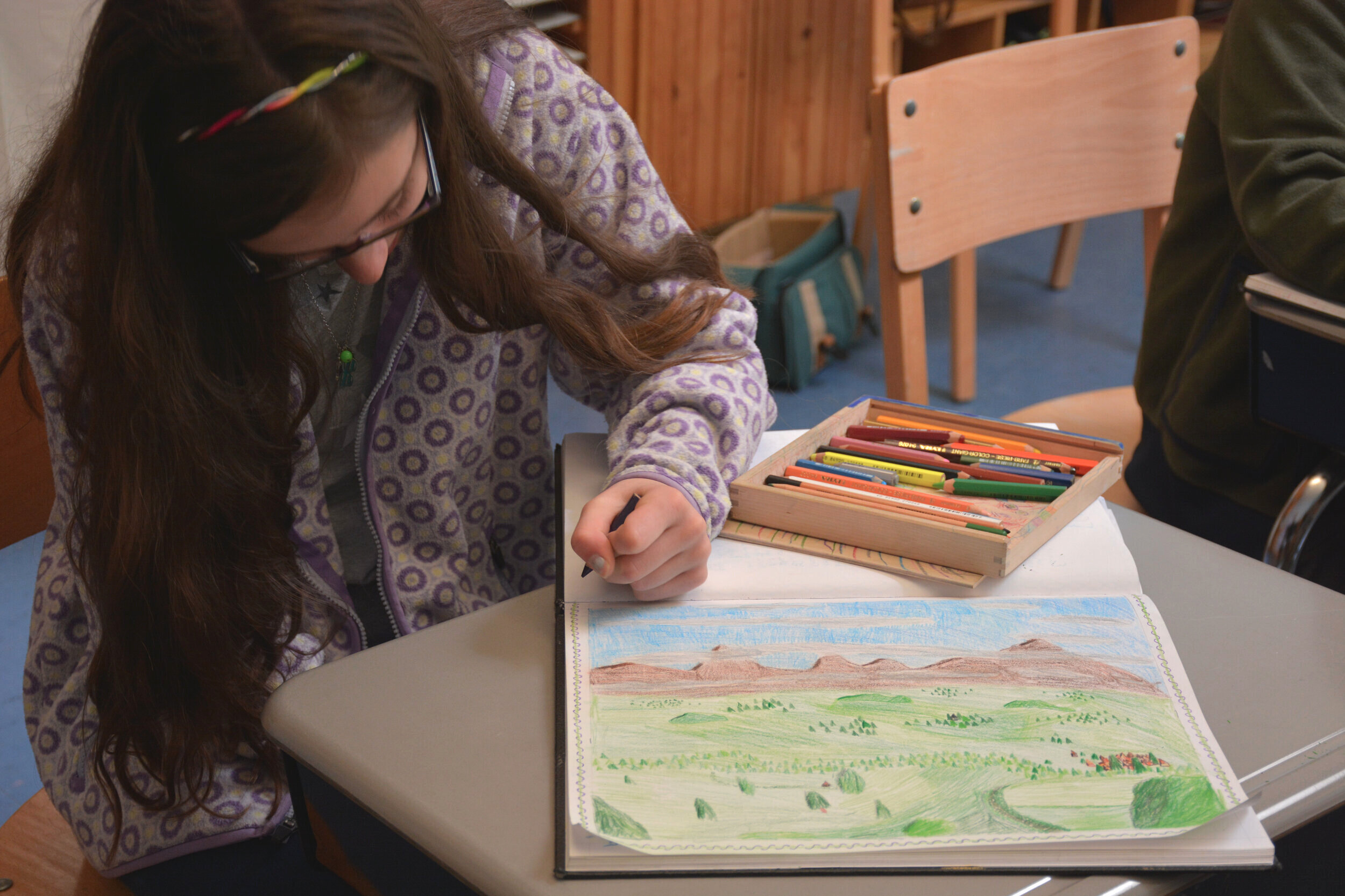Grades 6-8
In a Waldorf school, formal academic learning becomes more rigorous in the Middle School. Children at this stage, ages 12-14, still naturally learn through experience. However, they are now capable of critically examining and challenging both their own ideas and those that live beyond their direct experiences. This tendency is met with a curriculum that provides examples of the complexity and beauty inherent our world and individuals who changed it. With deep studies of revolutionary time periods, distant lands and inspiring individuals, children at this stage begin to appreciate the interconnected world they inhabit and their capacity to effect it. A Waldorf curriculum is one that unites academics, the arts, movement, practical work and a deep respect for the natural world.
Grade Six
Stabilizing Change
During the 12 year transition, the child experiences the fading of childhood and the birth-pangs of the individual. Physically and emotionally, it is a time of rapid growth and change. The curriculum models stability during this unsteady time.
The students explore the law and order of ancient Rome, and the birth of Western Civilization arising out of the turbulent Middle Ages. In math, symmetry and precision are requirements of constructive geometry. Students connect their senses with their thinking through formal observation in the science curriculum. Physics reveals the order of the natural world, mineralogy explores the foundations of our Earth, while astronomy stretches the imagination with its complex vastness. In Movement, children are joyfully challenged to learn the skills and dexterity of the circus arts.
Studies of business math and economics link mathematics to the practical world and students work with decimals and percent, ratios and reciprocals. The order of the focus of geography classes is left to the discretion of the teacher in Middle School. In the 6th grade, geography studies usually explore Europe and the Middle East in order to set the stage for learning about ancient Rome, Byzantium and the Middle Ages in Europe. Cyber civics is an area of study introduced in middle school. During 6th grade, students explore digital citizenship defined as the “norms of appropriate and responsible technology use”. Middle schoolers are also invited to join after school activities and clubs that are led by teachers and parent volunteers.
In addition to daily works in the arts including painting, drawing, sculpting, singing, and recorder, every child participates in weekly classes in German, strings, movement, handwork, wood work, and nature studies.
Grade Seven
Encouraging Exploration
In Grade 7, the students turn 13 and become teenagers. While a feeling and yearning for independence and solitude may be experienced, a certain anxiety, emotional sensitivity and embarrassment can run alongside. By directing their attention and interest out into the world, students are encouraged to take initiative and appreciate ideas, and to challenge attitudes and assumptions to form their own point of view.
Students learn about the volatile and creative atmosphere of the European Renaissance and Reformation and explore how these impacted the future of western development. Introduced to individuals who made contact with parts of the world unknown to them through historical biography, students are exposed to the vastly different and numerous impacts this contact had on Indigenous versus European peoples.
The geography work in Seventh Grade includes the study of lands, cultures and the oceans. The African and South American continents are studied and mapped, and economic issues such as food production, population, and resources are explored as students compare and contrast different landforms, vegetation, climate, and biomes. They also study the ancient civilizations of these areas and the subsequent European colonization that brought drastic changes to these continents
The Language Arts curriculum focuses on reinforcing past work with the basics of the English language. Poetry and creative writing, using the framework of “wish, wonder, and surprise”, helps give expression to the student’s increasingly complex feelings and perspectives.
In mathematics, students build on their knowledge of fractions, decimals, and percent. Students practice working with ratio and proportion, signed numbers, powers,and roots, and are introduced to Euclidean geometry and Algebra.
Chemistry and physiology are new science blocks introduced this year, while work in physics and astronomy continues. The goal of the science studies is to learn to distinguish between what was observed, what was thought, and what could be concluded when thought and observation are united.
The Renaissance discovery of the vanishing point in painting and architecture, where everything meets or from which everything emanates, is now the foundation for themes in drawing.
Cyber civics continues as a middle school topic with weekly classes in information literacy and “how to find, retrieve, analyze and use online information”.
In addition to daily works in the arts including painting, drawing, sculpting, singing, and recorder, every child participates in weekly classes in German, strings, movement, handwork, wood work, and nature studies.
Grade Eight
Revolution
At 14, the students are 'into' adolescence. Bodily and psychological changes are well under way, so that in general, the young person seems more robust and the tenderness of the previous two years has lessened.
Their striving for independence, with its rumblings of revolution, grows more tangible. It is accompanied by their will; that combination of energy, moral conviction and commitment. This will is a gift when it is focused on bettering themselves or their surroundings. To kindle their desire to change the world, grade eight, students study revolutions and revolutionaries including the French, American, and Industrial Revolutions as well as the Civil War and non-violent movements. Students also study the geography of Asia and Australia, perhaps with a focus on the Chinese Cultural Revolution.
When the grade eight students are searching to find their own new language, drama is an important theme in language arts. Shakespeare and his works are studied, and the class play is a larger theatrical project. Students are active in every technical aspect of the production: set design, lighting, sound, props, make-up, and costumes.
In geometry, students construct the five Platonic solids and use the Pythagorean theorem. Conversion of number bases is studied in depth. Arithmetic skills, the square root algorithm, and percent are all reviewed and continued. Students review and expand their knowledge of Algebra including positive and negative integers, law of exponents, the order of operations, expressions, equations, and polynomials. Students who successfully complete this curriculum are prepared for a ninth grade Algebra 1 class.
Anatomy and meteorology are new science blocks introduced this year, while work in physics and chemistry continues. Students are expected to provide accurate observations and to be precise in their conclusions of the underlying concepts. They further develop their skills in sketching, report writing and working as a team to draw conclusions.
Each student works to complete an 8th grade project this year as well. The purpose of this project is to acquire new and useful knowledge, create something interesting and educational, establish a working relationship with a mentor, practice meeting long-term deadlines, and deliver a poised, confident presentation to an audience.
In addition to daily works in the arts including painting, drawing, sculpting, singing, and recorder, every child participates in weekly classes in German, strings, movement, handwork, wood work, cyber civics, and nature studies.




